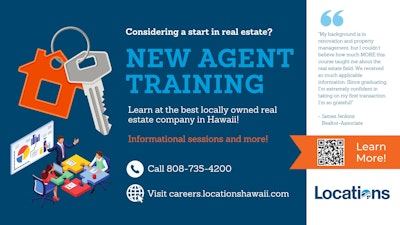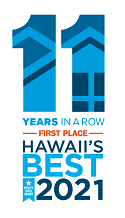
When you’re searching for a home, it’s important to consider other factors besides the property itself. Even if you fall in love with the condo’s amenities or the four-bedroom house, you’ll need to consider location, which should give you an idea of traffic times.
Hawaii tends to get a bad rap when it comes to traffic. In 2019, Honolulu was ranked 18th most congested city in the U.S. by INRIX, as drivers spent an average of 92 hours in traffic, costing them about $1,282 per person for gas. Here on Oahu, every resident will need to think about their commute to work or school and factor that into their daily schedule in some way.
We’ve seen a real estate expansion over the years on Oahu’s west side, as new homes and condos are being built and more work opportunities become available. Despite this shift, most high-paying jobs and many reputable schools are still in central urban Honolulu. While homes are certainly more affordable on Ewa Beach or Kaneohe, the distance from town does come at a cost. Many local residents living further away from the urban core would rather leave the house at 4 a.m. just to skip sitting in traffic for hours. Or, they might choose to leave work later, maybe at 7 p.m. instead of 5 p.m. They may spend more time at work, nap in the car at their company’s parking lot or come home late. This translates to less time spent at home.
However, it is worth noting that COVID-19 has shifted the way we work and study. People can now work from home or do distance learning. This has allowed some homebuyers to consider neighborhoods further from town than they may have previous written off due to a long commute.
If you work downtown and live in a central Honolulu home, a house in Manoa or a Kakaako luxury condo, you would rarely have to deal with crazy traffic. It’s the easiest way to beat traffic – you’ll avoid long commute hours completely. While living in town may be more expensive, you can skip traffic and enjoy more time at home, spend less gas money and enjoy proximity to urban and hip downtown, the beach, shopping centers and neighborhoods like Ala Moana or Kakaako.
The typical distance for most commutes in Honolulu is about 6.6 miles, but peak traffic hours sitting in gridlock can make those miles feel much longer. Take a look at these commute times per neighborhood:
- Central Honolulu, Kalihi and Kakaako:10 to 30 minutes
- North Shore, Laie, Makaha and Nanakuli: 120 to 160 minutes
- Waipahu: 45 to 120 minutes
- Ewa Beach: 60 to 120 minutes
- Pearl City and Aiea: 15 to 45 minutes
- Aina Haina, Hawaii Kai, Waimanalo and Kailua: 30 to 60 minutes
Weigh your options
When beautiful cities like Honolulu are subject to heavy traffic, residents may need to consider what they’re willing to sacrifice. What’s important for you and your family? If it’s important for you to own a large home with a backyard for your kids, the west side may be your option. Those hours spent on the road may be worth it if that’s what you envision for your family. On the other hand, you could decide to move into a smaller condo that’s closer to work, sacrificing space for time. Ultimately, it’s all about figuring out your budget and goals.
Traffic tips
Of course, not all of us are fortunate enough to have choices, and we may unfortunately have to deal with traffic every day. In fact, no matter where you live on the island, chances are you’ll have to deal with traffic at some point. The good news: if you plan ahead of time and drive smart, you’ll be able to avoid most of the congestion. Here are some tried-and-true tips that can help you make your commute that much easier.
1. Use your phone (responsibly)
Sometimes, the television or radio can be slightly delayed, especially if you don’t check on them as you leave the door. Stay up to date by using a real-time app, which can help you figure out what you need to do before you leave the house. Check a traffic app on your smartphone, such as Waze, Good Maps, Nixle or GoAkamai. There may have been an accident on H1 that’s caused a delay you didn’t foresee. These apps can provide you with alternate route options so you can avoid most of the congestion. You can also visit Honolulu.gov for updates. And of course, don’t use your phone in the car – use a magnetic holder so you can swipe safely.
2. Car pool
Carpooling is an environmentally friendly and sustainable way of sharing your journey on the road. If you happen to have friendly coworkers or classmates who live near your home, consider asking them to combine resources and share a vehicle. You can do this safely during COVID-19 by wearing a mask and distancing by having one person sit in the back. Carpooling can save fuel costs, relieve the stress of driving and get more people off the road to alleviate congestion. Discuss and agree on details such as costs, meeting times and taking turns driving.
3. Skip the car
Who says you have to drive? If you live closer to work, you can choose to leave your car at home and use your bicycle instead. You could also use the Biki, a large-scale bikeshare system in Honolulu. Although Biki is currently closed to the public due to COVID-19 (at the time of writing), it is convenient and easy to use. It has 130 convenient stops in urban Honolulu and accommodates riders of all sizes. Prices range from $15 to $25 per month.
You could also get a bus pass. As of 2020, the monthly bus pass is at $70, with unlimited rides for the month. And Honolulu’s rail transit system is scheduled for completion in 2026 (LINK TO RAIL BLOG).
4. Manage stress
Life happens. Sometimes an accident may happen on the road while you’re driving, which can derail plans. Think about having an emergency traffic plan in place. Download audiobooks ahead of time or listen to an educational podcast to learn a new skill. Create a playlist of music you enjoy. Call up a friend over Bluetooth and catch up. Do your best to manage stress and drive safely and calmly.
Congratulations, you have access to Hawaii's most comprehensive Real Estate Search! Please help us to better serve you by answering these optional questions.
Facebook Registration
This email is already registered. Click the button below and we'll send you a link to reset your password.
You have already registered using your FB account.
Check your inbox for an email from brokersmls@locationshawaii.com. It contains a link to reset your password.
The agent who gave you access to this website is no longer with Locations LLC.
Due to local MLS regulations, you will need to re-register if you would like to continue your access.
We will pre-fill the registration form with information in our files. Once you click Register you can either select a new agent or one will be assigned for you.
Sorry for the inconvenience, Locations LLC.
Schedule a Virtual Tour
Request an appointment to view this property by completing the information below. Please note your appointment is not confirmed until an agent calls you.
Disclaimer: The properties we may show you may be Locations LLC listings or listings of other brokerage firms. Professional protocol requires agent to set up an appointment with the listings agent to show a property. Locations, LLC may only show properties marked "Active" and "ACS".
Listings in
Additional Criteria
Keep your eye on this property! Save this listing and receive e-mail updates if the status of the property changes.
Share this property by completing the the form below. Your friend will receive an e-mail from you with a link to view the details of this property.
How can we help?
Send a message and we'll respond shortly.
We will not rent, share, or sell your information. Privacy Policy.










